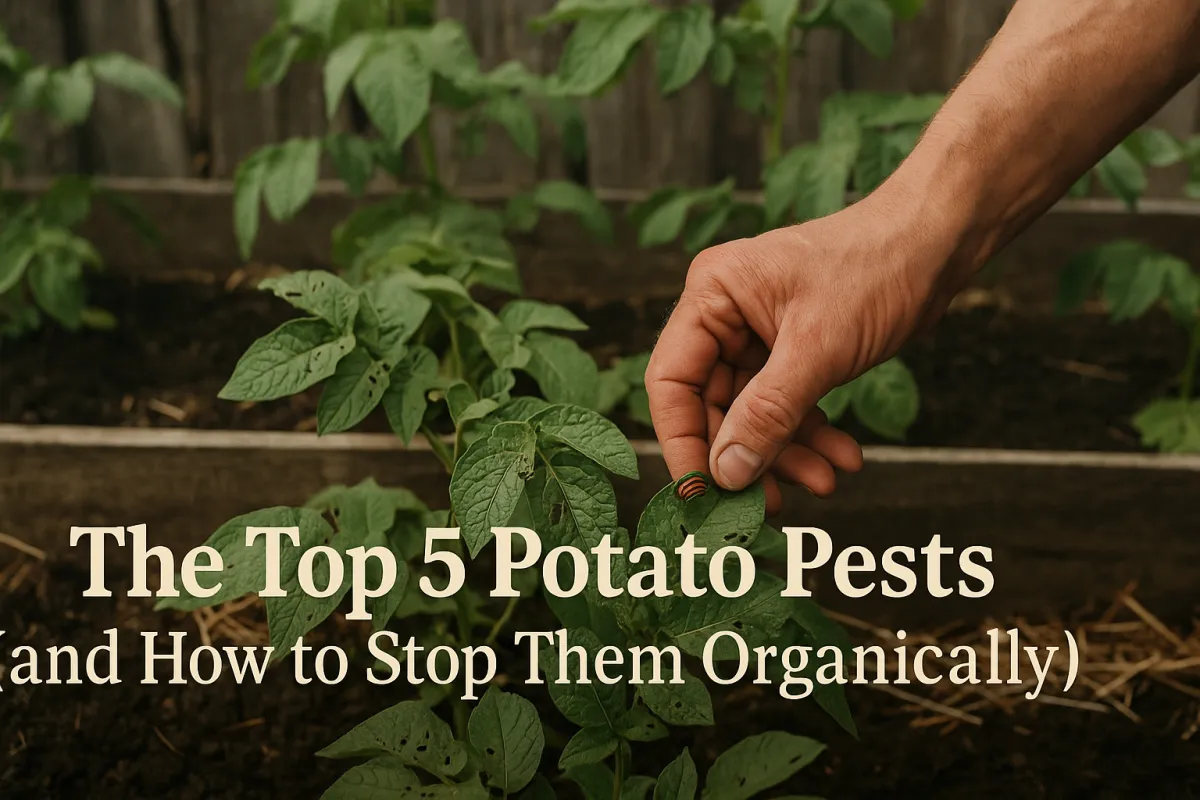
The Top 5 Potato Pests (and How to Stop Them Organically)
The Top 5 Potato Pests (and How to Stop Them Organically)
How I lost my first row—and how you don’t have to
Potatoes, Pests, and a Patch Gone Wrong
One spring not long after I got serious about growing food, I planted an entire 20-foot row of Yukon Golds. I hilled them right. Watered them deep. Even laid straw between the rows like Grandma used to. And then I looked away for a week. When I came back, the tops were ragged skeletons, crawling with striped beetles and their fat red larvae. I lost almost everything.
Potatoes are a magnet for pests—especially if you’re growing organically and trying to do things right. But pests don’t mean failure. If you know what to look for (and when), you can head off the damage, stop it early, and still pull a solid harvest come midsummer.
Here’s what I’ve learned the hard way about the top five potato pests—and how to stop them without spraying poison all over your food.
1. Colorado Potato Beetles: The Relentless Leaf Munchers
If you’ve seen bright yellow-striped beetles clinging to the tops of your potato leaves, you’ve met the enemy. And their soft-bodied red larvae do even more damage than the adults.
These pests eat fast and multiply faster. In Zone 5, I usually spot the first wave by late May. Warmer zones? You might see them as early as April.
What to Do:
Flip the leaves every morning and hand-pick both beetles and larvae. They’re slower in the morning and easier to knock into a jar of soapy water.
Spray neem oil on newly hatched larvae. Repeat after rain.
Rotate crops every year and avoid planting in the same bed twice in a row.
Plant early if your zone allows—it can throw off the beetle lifecycle.
Grandma’s tip: “Flip the leaves. That’s where the war starts.”
Late-season rescue: If your plants are overwhelmed, prune heavily damaged stems and double down on hand-picking + neem. You can still salvage the crop if the vines have time to regrow.
2. Wireworms: The Silent, Underground Destroyers
Wireworms are the larvae of click beetles—and they love potatoes. The worst part? You usually don’t know they’re there until you dig up ruined tubers in midsummer.
They tunnel from the inside, leaving shallow holes that invite rot in storage. I’ve lost entire buckets to soft spots from wireworm damage.
What to Do:
Set traps by burying halved potatoes in shallow containers. Check daily.
Break up sod well before planting; wireworms love compacted, grassy soil.
Rotate with brassicas or legumes, which don’t host them.
Solarize or flood soil in small beds before planting if pressure has been bad.
Zone note: Wireworms thrive in cool, moist soils. If you’re in Zone 4–6, keep beds loose and warm to discourage them.
3. Aphids: The Tiny Virus Spreaders
Aphids are small, but the damage adds up fast—especially if they’re spreading mosaic viruses. Look for curled or yellowed leaves, sticky sap on stems, and clusters hiding under leaves.
Once virus infection sets in, your harvest will be weak and your storage tubers won’t keep.
What to Do:
Spray plants with a hard stream of water to knock aphids off.
Use insecticidal soap or neem for ongoing control.
Clip and compost infected leaves as soon as you spot them.
Plant trap crops like nasturtiums a few feet away to lure aphids elsewhere.
Avoid nitrogen-heavy fertilizers that cause lush growth—aphids love it.
Encourage beneficial insects like ladybugs and lacewings. In a healthy garden, they’ll keep the aphid population in check.
4. Flea Beetles: Death by a Thousand Holes
These tiny, jumpy beetles leave pin-sized holes in young potato leaves. One or two bites won’t kill a plant—but enough of them, and your crop will stall out before it gets going.
I’ve had seedlings take a full two weeks longer to mature after a flea beetle invasion.
What to Do:
Use floating row covers right after planting to keep beetles off until plants are stronger.
Spray kaolin clay, which forms a natural deterrent barrier.
Plant radishes early nearby as a trap crop—they’ll eat those instead.
Clean up old mulch, weeds, and debris that harbor overwintering beetles.
Zone tip: In Zone 5, flea beetles show up when the soil hits 50°F—usually early May.
5. Cutworms: The Overnight Assassins
These are the culprits when you wake up and a healthy potato plant has been snapped at the base. Cutworms are soil-dwelling caterpillars that come out at night and chew straight through stems.
They don’t eat the foliage. They just kill.
What to Do:
Make collars from toilet paper rolls or plastic cups—bury them halfway to block access.
Till in late fall to expose and destroy overwintering larvae.
Sprinkle crushed eggshells or coffee grounds around the base of plants—rough textures slow them down.
Attract birds and toads to help keep population down.
If it’s too late: Replant if early in the season. A few lost plants can be replaced with sprouted extras from your seed stash.
Companion Planting and Smart Timing
Plant partners that help:
Horseradish — repels beetles
Bush beans — help deter beetles and improve soil
Marigolds — general deterrent and aphid distractor
Trap crops that work:
Eggplant attracts beetles (more than potatoes)
Radishes draw in flea beetles
Timing tactics:
Plant early to avoid peak pest pressure (especially in cooler zones)
Late fall cleanup is essential — remove debris that harbors eggs or larvae
Final Thoughts: Stewardship Is in the Watching
You don’t need synthetic sprays or lab-made dust to grow a healthy potato crop. What you need is vigilance, early action, and a system that works with nature instead of against it.
Organic pest control isn’t passive. But the reward is big: cleaner harvests, better storage, and food you can trust.
“This kind of stewardship—knowing your land, protecting your food—is how we reclaim what was always ours.”


Facebook
Instagram
X
Youtube